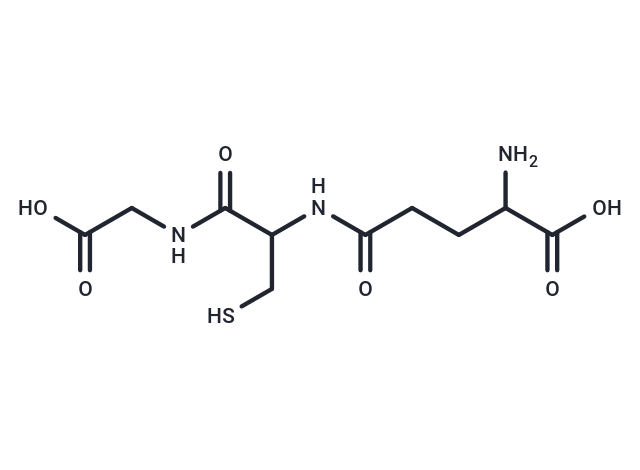Shopping Cart
- Remove All
 Your shopping cart is currently empty
Your shopping cart is currently empty

L-Glutathione reduced (Glutathione) is a naturally occurring tripeptide found in cells as an endogenous antioxidant that scavenges oxygen free radicals. L-Glutathione reduced is a cofactor for certain enzymes and is involved in the rearrangement of protein disulfide bonds and the reduction of peroxides.

| Pack Size | Price | Availability | Quantity |
|---|---|---|---|
| 1 g | $32 | In Stock | |
| 5 g | $42 | In Stock |
| Description | L-Glutathione reduced (Glutathione) is a naturally occurring tripeptide found in cells as an endogenous antioxidant that scavenges oxygen free radicals. L-Glutathione reduced is a cofactor for certain enzymes and is involved in the rearrangement of protein disulfide bonds and the reduction of peroxides. |
| In vitro | METHODS: NSCs cells were treated with L-Glutathione reduced (0.5 mM) and sevoflurane (3%) for 24 h. Apoptosis was detected using TUNEL staining. RESULTS: Supplementation with reduced L-Glutathione reduced the effect of sevoflurane on apoptosis of NSCs. [1] |
| In vivo | METHODS: To study in vivo activity, L-Glutathione reduced (100 mg/kg) was administered orally to mice and GSH concentrations were measured in plasma at 30, 45, and 60 min, and in the liver, kidneys, heart, lungs, brain, small intestine, and skin 1 h later. RESULTS: Within 30 min of oral L-Glutathione reduced administration, plasma GSH concentrations increased from 30 µM to 75 µM, consistent with a rapid flow of GSH from the intestinal lumen to the plasma. Under these conditions of GSH sufficiency, GSH concentrations in most tissues did not exceed control values over the same time course, with the exception of lung. [2] |
| Alias | γ-L-Glutamyl-L-cysteinyl-glycine, Tathion, Isethion, GSH, Glutathione, Glutathion |
| Molecular Weight | 307.32 |
| Formula | C10H17N3O6S |
| Cas No. | 70-18-8 |
| Smiles | NC(CCC(=O)NC(CS)C(=O)NCC(O)=O)C(O)=O |
| Relative Density. | 1.441 g/cm3 |
| Storage | keep away from direct sunlight | Powder: -20°C for 3 years | Shipping with blue ice. | |||||||||||||||||||||||||||||||||||
| Solubility Information | DMSO: Insoluble, The compound is unstable in solution. Please use soon. H2O: 153.7 mg/mL (500.13 mM), Sonication is recommended. | |||||||||||||||||||||||||||||||||||
Solution Preparation Table | ||||||||||||||||||||||||||||||||||||
H2O
| ||||||||||||||||||||||||||||||||||||

Copyright © 2015-2025 TargetMol Chemicals Inc. All Rights Reserved.